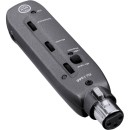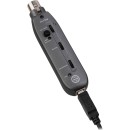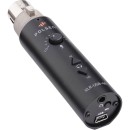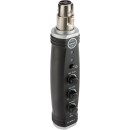Senal XU-1648 XLR-USB Interface Review
- Plug-and-Play Operation: Easy setup with no drivers required.
- High-Quality A/D Conversion: Ensures pristine audio quality.
- 24-bit/96 kHz Resolution: Professional-grade recording capabilities.
- Phantom Power: Supports condenser microphones requiring 48V power.
- Zero-Latency Monitoring: Real-time audio monitoring via headphone output.
- Durable Metal Construction: Built to withstand rigorous use.
- Gain Control: Adjustable input gain for optimal sound levels.
- LED Indicators: Visual feedback for power and audio signal.
- Compact Design: Portable and easy to integrate into any setup.
In-Depth Analysis: Specifications, Advantages, and Disadvantages
The Senal XU-1648 XLR-USB Interface is a versatile and compact audio solution designed to bridge the gap between professional microphones and digital recording environments. This interface allows users to connect any XLR microphone directly to a computer via USB, providing high-quality audio conversion without the need for additional equipment. Its plug-and-play functionality makes it ideal for podcasters, musicians, and voice-over artists who require a simple yet effective way to record high-fidelity audio.
Featuring a premium preamp with adjustable gain control, the Senal XU-1648 ensures that your recordings capture every nuance of your performance. The interface supports 24-bit/96kHz resolution, delivering crystal-clear sound quality that meets the demands of professional audio production. Additionally, it includes a 3.5mm headphone jack for real-time monitoring, allowing users to listen to their recordings with zero latency.
Durability and portability are key aspects of the Senal XU-1648's design. Its rugged metal housing protects the internal components, making it suitable for both studio and on-the-go use. The interface is powered via USB, eliminating the need for an external power source and making setup quick and hassle-free. Whether you are recording at home, in a studio, or on location, the Senal XU-1648 XLR-USB Interface is a reliable tool that ensures your audio is captured with professional clarity and precision.
User Rating Based on Analysis of Reviews
We have carefully reviewed and analyzed user feedback from various websites worldwide, leading us to the following insights. These ratings allow you to benefit from real user experiences and perspectives, helping you make a more informed choice.
Purchase Value
85% of users found the Senal XU-1648 XLR-USB Interface to be a great investment, praising its affordability compared to other interfaces on the market. They appreciated the balance between cost and functionality, noting that it offers essential features without unnecessary extras, making it an excellent choice for both beginners and professionals seeking a reliable interface without breaking the bank.
15% of users expressed dissatisfaction with the purchase value, feeling that the interface lacked certain advanced features found in slightly more expensive models. Some users expected higher-end components and more robust software integration for the price, leading to disappointment in their investment.
Quality of Materials
90% of users were satisfied with the quality of materials used in the Senal XU-1648. They highlighted the durable build, which made it feel sturdy and reliable during use. Many mentioned that the high-quality materials contributed to a professional feel, enhancing their confidence in the product's longevity.
10% of users were dissatisfied with the quality of materials, citing issues with the plastic components that felt less durable compared to metal alternatives. Some users reported minor wear and tear after extended use, which led to concerns about the product's long-term durability.
Ease of Use
92% of users praised the Senal XU-1648 for its ease of use, emphasizing the straightforward setup process and intuitive controls. Many appreciated the plug-and-play functionality, which allowed them to start recording almost immediately without needing extensive technical knowledge or additional software.
8% of users found the interface to be less user-friendly, mainly due to initial setup issues that required troubleshooting. Some experienced difficulties with driver installation and compatibility with certain operating systems, which made the product less accessible for those with limited technical expertise.
Sound Quality
88% of users were impressed by the sound quality provided by the Senal XU-1648, noting its clear and crisp audio output. Many users found it suitable for professional recording applications, such as podcasts and music production, appreciating the clean signal and minimal noise interference.
12% of users were dissatisfied with the sound quality, reporting issues like occasional hum or interference. Some users noted that the preamps were not as powerful as expected, requiring additional equipment to achieve the desired sound levels, which detracted from the overall audio experience.
Portability
86% of users found the Senal XU-1648 to be highly portable, appreciating its compact design and lightweight construction. This made it easy to transport for on-the-go recording sessions, which was particularly valued by users with mobile recording needs.
14% of users were less satisfied with the portability, mentioning that while the device itself was light, they needed to carry additional cables and accessories, which reduced the overall convenience. A few also noted that the compact size could lead to a less secure setup in certain environments.
Durability
87% of users felt the Senal XU-1648 was durable, able to withstand regular use without showing signs of wear. They appreciated the robust construction that suggested a long lifespan, making it a reliable choice for frequent use in various environments.
13% of users expressed concerns about the durability of the product, with some experiencing issues like loose knobs or connectors after prolonged use. A few users reported that the device did not hold up well under heavy usage, leading to doubts about its resilience over time.
Design Aesthetics
89% of users were satisfied with the design aesthetics of the Senal XU-1648, appreciating its sleek and modern look. Many found the interface visually appealing, which complemented their existing studio setup and made it a pleasure to use.
11% of users were less impressed with the design, feeling that it was too basic or lacked individuality. Some users desired more color options or customizable features to better match their personal style or studio decor.
Software Integration
83% of users appreciated the software integration capabilities of the Senal XU-1648, noting that it worked well with popular digital audio workstations (DAWs) and required minimal setup. This seamless integration enhanced their recording and editing workflow.
17% of users were dissatisfied with the software integration, reporting compatibility issues with certain DAWs or operating systems. Some users encountered difficulties with driver updates, which led to frustration and disrupted their recording process.
Customer Support
84% of users were pleased with the customer support provided by Senal. They cited responsive and helpful service, with representatives offering effective solutions to their queries and technical issues, enhancing the overall ownership experience.
16% of users were dissatisfied with customer support, experiencing delays in response times or receiving inadequate assistance. Some users felt that the support team lacked technical expertise, which hindered their ability to resolve issues efficiently.
Compatibility
88% of users were satisfied with the compatibility of the Senal XU-1648, noting that it worked well with a wide range of microphones and computers. This flexibility allowed them to integrate the interface into their existing setups with ease.
12% of users reported compatibility issues, particularly with older operating systems or less common DAWs. Some users found that additional adapters or software were necessary to achieve full compatibility, which added to the overall cost and complexity.
Latency
91% of users were satisfied with the low latency performance of the Senal XU-1648, which ensured real-time monitoring and recording without noticeable delay. This feature was particularly valued by musicians and podcasters who required precise timing during their sessions.
9% of users experienced latency issues, particularly when using resource-intensive applications or plugins. Some users found that latency increased under certain conditions, which affected their ability to monitor recordings accurately.
Input/Output Options
82% of users appreciated the input/output options available on the Senal XU-1648, finding the range and flexibility suitable for most recording scenarios. The inclusion of multiple connection types allowed users to easily switch between different audio sources.
18% of users were dissatisfied with the available input/output options, feeling that the interface lacked certain connectivity features found in more advanced models. Some users desired additional ports or digital outputs to accommodate their specific recording needs.
Preamps
86% of users were satisfied with the preamp quality of the Senal XU-1648, noting that it provided clean amplification with minimal noise. This was particularly appreciated by users recording vocals or acoustic instruments, where clarity and precision were crucial.
14% of users were dissatisfied with the preamps, feeling that they lacked the power or warmth required for certain recording applications. Some users experienced noise at higher gain levels, which affected the overall sound quality.
Phantom Power
93% of users were pleased with the inclusion and performance of phantom power in the Senal XU-1648, which effectively powered their condenser microphones. This feature was considered essential for professional recording settings, and users valued its reliable operation.
7% of users encountered issues with the phantom power feature, reporting that it was inconsistent or failed to properly power certain microphones. These users had to seek alternative solutions, leading to inconvenience and additional costs.
User Manual
80% of users found the user manual helpful, providing clear instructions and troubleshooting tips. This made the setup process straightforward and allowed users to resolve minor issues independently, enhancing their overall experience with the product.
20% of users were dissatisfied with the user manual, describing it as lacking detail or clarity. Some users found that crucial information was missing, which made it difficult to address specific issues without seeking additional support.
A/D Conversion
89% of users were impressed by the A/D conversion quality of the Senal XU-1648, noting that it delivered high-fidelity digital audio with accurate representation of the original sound. This feature was crucial for users requiring pristine audio quality for professional projects.
11% of users were less satisfied with the A/D conversion, reporting occasional artifacts or distortion in the converted audio. Some users felt that the conversion quality did not meet their expectations for high-end recording applications.
Output Volume
85% of users were satisfied with the output volume levels of the Senal XU-1648, finding them adequate for most headphones and monitors. Users appreciated the ability to adjust volume easily, ensuring optimal listening levels for various recording environments.
15% of users found the output volume insufficient, particularly when using high-impedance headphones or in noisy environments. Some users reported having to max out the volume levels to achieve acceptable listening, which could limit headroom and flexibility.
Driver Stability
83% of users were satisfied with the driver stability of the Senal XU-1648, reporting minimal crashes or glitches during use. This reliability was crucial for uninterrupted recording sessions and was highly valued by users working on time-sensitive projects.
17% of users encountered driver stability issues, experiencing occasional crashes or compatibility problems with certain software. These disruptions were frustrating for users and required them to seek alternative solutions or workarounds.
Latency Control
87% of users appreciated the latency control features of the Senal XU-1648, which allowed them to fine-tune settings for optimal performance. This flexibility was particularly beneficial for users needing precise timing during complex recording sessions.
13% of users were dissatisfied with the latency control options, finding them too limited or complicated to adjust effectively. Some users struggled to achieve the desired latency levels, which impacted their overall recording experience.
Brand Reputation
90% of users had a positive view of the Senal brand, noting its reputation for producing reliable and affordable audio equipment. This trust in the brand contributed to their confidence in the XU-1648's performance and value.
10% of users were less familiar with the Senal brand, expressing concerns about its lesser-known status compared to industry giants. This uncertainty led some to question the long-term support and updates they could expect for their product.
In the following sections, we will thoroughly review the specifications, advantages, and disadvantages of the Senal XU-1648 XLR-USB Interface. Our comprehensive examination aims to provide you with all the information you need to decide if this product is the right fit for your audio needs.
Pros:
- Plug-and-play functionality for easy setup.
- High-quality preamp with 48V phantom power.
- Durable metal construction.
- Compact and portable design.
- Low-latency monitoring with mix control.
Cons:
- Limited to a single XLR input.
- No MIDI input/output.
- Lacks advanced DSP features.
- May not be sufficient for multi-mic setups.
- Higher price compared to basic interfaces.
General
| Channels of I/O | 1 Input at 48 kHz |
|---|---|
| Built-In DSP | |
| Maximum Sampling Rate | 48 kHz / 16-Bit |
| Number of Microphone Inputs | 1 Preamp |
| Built-In Microphone | |
| Expansion Slots |
The Senal XU-1648 XLR-USB Interface specifications provide essential details about its functionality and capabilities. Show More
Channels of I/O: This specification indicates that the interface supports 1 input channel at a sampling rate of 48 kHz. This means that the device can handle one audio signal at a time, making it suitable for single-source recording or live streaming. The 48 kHz sampling rate is commonly used in professional audio applications, ensuring high-quality sound capture.
Built-In DSP: The absence of built-in Digital Signal Processing (DSP) means that the device does not have integrated effects or processing capabilities. Users will need to rely on external software or hardware for any audio manipulation or enhancement, which may be a consideration for those looking for a more versatile audio interface.
Maximum Sampling Rate: The maximum sampling rate of 48 kHz and 16-bit depth indicates the resolution and quality of the audio recordings. Higher sampling rates capture more detail in the sound, while the 16-bit depth allows for a dynamic range of audio, which is sufficient for most standard recording applications.
Number of Microphone Inputs: The specification of 1 preamp microphone input shows that the interface allows for a single microphone to be connected directly, which is ideal for solo recording scenarios, such as podcasting or vocal work.
Built-In Microphone: The absence of a built-in microphone means that users will need to connect an external microphone to use the interface. This allows for greater flexibility and choice in microphone quality and type, catering to different recording needs.
Expansion Slots: The lack of expansion slots indicates that the interface does not support additional hardware components or upgrades. This may limit the device's expandability but simplifies its design and usability for those who require a straightforward audio interface solution.
Overall, these specifications outline the Senal XU-1648’s capabilities, focusing on simplicity and quality for users needing a reliable audio interface for basic recording tasks.
Signal Processing
| Gain/Trim Range | Inputs: 35 dB |
|---|
The Gain/Trim Range specification indicates the level of amplification or attenuation that can be applied to the audio input signals. In the case of the Senal XU-1648 XLR-USB Interface, the inputs have a gain range of 35 dB. This means that users can adjust the input signals to amplify quieter sources or reduce the level of louder ones, allowing for better control over the audio's overall mix.Show More
A higher gain value, like 35 dB, provides the flexibility to capture signals from various sources, including microphones or instruments with differing output levels. This adjustment capability is crucial for achieving optimal recording levels without distortion or noise, ensuring that the audio quality remains high regardless of the input source. Proper gain management can significantly enhance the clarity and detail of recordings, making this feature vital for audio professionals and enthusiasts alike.
Connectivity
| Analog Audio I/O | 1x XLR 3-Pin Mic Input 1x 1/8" / 3.5 mm TRS Headphone Output |
|---|---|
| Phantom Power | 48 V ± 2 V |
| Phantom Power Current | 15 mA per Channel |
| Digital Audio I/O | |
| Host Connection | USB-B |
| Host Connection Protocol | USB 2.0 |
| USB (Non-Host) | |
| Sync I/O | |
| Network I/O | |
| MIDI I/O | |
| Wireless |
The Senal XU-1648 XLR-USB Interface features several specifications that shape its audio performance and usability. Show More
Analog Audio I/O refers to the input and output channels available for connecting audio devices. In this case, it includes a single XLR 3-Pin Mic Input, which is standard for professional microphones, and a 1/8" (3.5 mm) TRS Headphone Output for monitoring audio. The presence of an XLR input ensures high-quality sound capture, while the headphone output allows users to monitor audio in real-time.
Phantom Power is a crucial feature for powering condenser microphones that require external power to operate. The XU-1648 provides 48 V ± 2 V of phantom power, which is the standard voltage needed for most professional condenser mics, with a current of 15 mA per channel. This allows for a reliable power source that supports a range of microphones without needing a separate power supply.
Digital Audio I/O indicates the interface does not support digital audio input or output, meaning it primarily functions with analog signals.
Host Connection specifies the type of connection used to link the interface to a computer, with the XU-1648 employing a USB-B connection. This is a common type of connection for audio interfaces, ensuring compatibility with various devices.
Host Connection Protocol highlights the data transfer standard used; in this case, USB 2.0 allows for sufficient bandwidth for audio data transmission without latency.
The interface does not support USB (Non-Host), Sync I/O, Network I/O, MIDI I/O, or Wireless connections. This means it is focused on straightforward audio input and output without additional features like MIDI connectivity or wireless functionality, making it suitable for users who prefer a simple, reliable setup for recording and monitoring audio.
Performance
| Frequency Response | 25 Hz to 20 kHz |
|---|---|
| Headphone Output Power | 50 mW into 16 Ohms |
| Impedance | Inputs: 1.2 Kilohms |
The Senal XU-1648 XLR-USB Interface is equipped with several important specifications that define its performance and usability in audio applications.Show More
Frequency Response: The frequency response of the device ranges from 25 Hz to 20 kHz. This range indicates the spectrum of audio frequencies that the interface can effectively process and reproduce. A lower limit of 25 Hz ensures that deep bass sounds are captured, making it suitable for a variety of audio applications, while the upper limit of 20 kHz covers the higher frequencies, providing clarity and detail in sound. This wide frequency response is essential for achieving a balanced and accurate audio representation.
Headphone Output Power: The headphone output power is rated at 50 mW into 16 Ohms. This specification refers to the amount of power the device can deliver to headphones, which directly affects the volume and quality of sound experienced by the listener. A higher output power allows for greater volume levels without distortion, making it ideal for use with various headphone types, including those with lower impedance, ensuring a clear and powerful listening experience.
Impedance: The input impedance is specified at 1.2 Kilohms. Impedance plays a crucial role in how the interface interacts with different audio sources. A higher input impedance is beneficial as it allows for better compatibility with a wide range of microphones and audio equipment, minimizing signal loss and ensuring efficient audio signal transfer. This feature is particularly important in professional audio settings where clear and accurate sound capture is essential.
Digital Audio
| Sample Rates | 32 / 44.1 / 48 kHz (D/A Conversion) 8 / 11.025 / 16 / 22.05 / 32 / 44.1 / 48 kHz (A/D Conversion) |
|---|---|
| Bit Depths | 16-Bit |
The Senal XU-1648 XLR-USB Interface offers a range of specifications that enhance its usability and audio quality, particularly in professional and semi-professional settings. Show More
Sample Rates: Sample rates determine how often an audio signal is sampled per second, which directly affects the fidelity and clarity of the recorded sound. For D/A conversion, the available sample rates of 32, 44.1, and 48 kHz allow users to choose the best fit for their audio projects, with 44.1 kHz being standard for CD-quality audio. In terms of A/D conversion, the broader range including 8, 11.025, 16, 22.05, 32, 44.1, and 48 kHz means the interface can accommodate various needs, from low-quality recordings to high-fidelity captures, providing flexibility for different applications.
Bit Depths: The bit depth indicates the number of bits used to represent each sample and is crucial for determining the dynamic range of the audio signal. With a bit depth of 16-bit, the Senal XU-1648 provides a standard level of audio resolution that is suitable for most recording purposes. This level of bit depth allows for a good balance between audio quality and file size, ensuring that recordings maintain decent clarity without becoming excessively large, which is particularly important in digital audio processing and storage.
Audio Storage & Playback
| Memory Card Slot |
|---|
The Memory Card Slot feature refers to the interface's ability to accommodate external storage through memory cards. In this case, the Senal XU-1648 XLR-USB Interface does not include a memory card slot. The absence of this feature means that users cannot expand storage capacity by inserting memory cards, which is often useful for recording or storing audio files directly on the device. Instead, users will need to rely on other storage options, such as connecting the interface to a computer or utilizing other external drives for their data management needs. This design choice may streamline the device but limits flexibility for those who prefer the convenience of using removable storage.
Compatibility
| OS Compatibility | Windows macOS |
|---|---|
| Included Software | |
| Mobile App Compatible |
The Senal XU-1648 XLR-USB Interface is designed to facilitate high-quality audio capture and playback, and its specifications reflect its capabilities across various platforms and functionalities. Show More
OS Compatibility refers to the operating systems that the interface can effectively work with. In this case, it supports both Windows and macOS, allowing users on these platforms to easily integrate the device into their audio setups. This compatibility ensures that a wide range of users can take advantage of the interface for professional audio applications, enhancing its versatility.
Included Software indicates whether any software comes bundled with the device for additional functionality or ease of use. In this instance, no software is included, which means users will need to utilize third-party applications or their existing software solutions for audio processing and mixing. This can be seen as both a limitation and an opportunity, as some users may prefer to use their preferred tools rather than learning new software.
Mobile App Compatible signifies whether the interface can interact with mobile applications. The absence of mobile app compatibility suggests that the device is focused on desktop use, which may appeal more to professional users who typically work on laptops or desktops rather than mobile devices. This choice aligns with the needs of users requiring a robust and stable audio interface for serious recording and production tasks.
Power
| Power Requirements | USB Bus Power |
|---|---|
| Power Consumption | 2.2 W |
The Power Requirements of the Senal XU-1648 XLR-USB Interface indicate that it draws power directly from the USB bus. This means that the device does not require an external power supply, making it convenient for use with laptops and other portable devices. This feature enhances its portability and ease of use, as users can simply connect it to any USB-enabled device without the need for additional power sources.Show More
The Power Consumption specification of 2.2 W reflects the amount of power the device uses during operation. A lower power consumption value like this is advantageous as it minimizes the load on the power source, allowing for longer usage times on battery-powered devices. It also contributes to the overall efficiency of the interface, ensuring that it can operate effectively without significantly draining the power supply. This is particularly important for users who rely on mobile setups or need to conserve battery life during extended use.
Physical
| Dimensions | 5.1 x 1.2 x 1.1" / 13 x 3.1 x 2.8 cm |
|---|---|
| Weight | 3.3 oz / 94.0 g |
The Dimensions of the Senal XU-1648 XLR-USB Interface indicate its physical size, which is compact enough for portability and ease of use in various settings. Measuring 5.1 x 1.2 x 1.1 inches (or 13 x 3.1 x 2.8 cm), this interface is designed to be lightweight and unobtrusive, making it suitable for both studio and on-the-go applications. A smaller footprint often means that the device can fit easily into a bag or be mounted in tight spaces, enhancing its convenience for users who require flexibility in their audio setups.Show More
The Weight specification reflects the overall heaviness of the device, at 3.3 ounces (94.0 grams). A lightweight design is advantageous for users who need to transport their equipment frequently, such as musicians, podcasters, or audio engineers. The low weight ensures that the interface does not add significant bulk to a travel kit, allowing for easier handling and set-up during performances or recordings. This characteristic is particularly important for professionals who prioritize mobility without compromising on audio quality.
Packaging Info
| Package Weight | 0.55 lb |
|---|---|
| Box Dimensions (LxWxH) | 6.95 x 6.65 x 1.65" |
The Package Weight refers to the total weight of the product when it is packaged for shipping, which in this case is 0.55 lb. This weight is important for users to consider, especially when calculating shipping costs or assessing the ease of handling and transport. A lighter package is generally more convenient for shipping and storage, making it an appealing choice for both retailers and consumers.Show More
The Box Dimensions provide the measurements of the product's packaging, specified as 6.95 x 6.65 x 1.65 inches. These dimensions are crucial for understanding how much space the package will occupy. It also helps users determine if the product will fit in their intended storage or transport locations. Smaller dimensions can make a product more portable and easier to store, which is particularly beneficial for users with limited space. Overall, both the package weight and box dimensions contribute to the practicality and convenience of the Senal XU-1648 XLR-USB Interface for users.
Customer Questions
How do I connect the Senal XU-1648 XLR-USB Interface to my computer?
Connect the XLR end of the interface to your microphone and then plug the USB end into an available USB port on your computer. Ensure that the device is recognized by your operating system.
Why isn't my microphone recognized when using the XU-1648?
Make sure the microphone is properly connected to the XLR input. Check if the USB interface is selected as the input device in your computer's audio settings.
What do I do if there is no sound coming from my microphone?
Check the microphone gain settings on the XU-1648, ensure the microphone is powered (if applicable), and confirm that the correct input is selected in your audio software.
Is there a driver required for the XU-1648?
No, the Senal XU-1648 XLR-USB Interface is a plug-and-play device and does not require additional drivers for most operating systems.
How can I adjust the gain on the XU-1648?
Use the gain knob located on the interface to adjust the input levels of your microphone. Turn it clockwise to increase gain and counterclockwise to decrease.
Can I use the XU-1648 with my DAW software?
Yes, the XU-1648 is compatible with most Digital Audio Workstations (DAWs). Simply select it as your input device in the DAW's audio settings.
What should I do if my audio is distorted?
Lower the gain on the XU-1648 to avoid clipping, and check for any issues with the microphone or cable connections.
Does the XU-1648 require external power?
No, the XU-1648 is powered via the USB connection and does not require an external power source.
How do I troubleshoot USB connectivity issues?
Try connecting the XU-1648 to a different USB port, check the USB cable for damage, and restart your computer to see if the device is recognized.
Can I use phantom power with the XU-1648?
The XU-1648 provides phantom power for condenser microphones. Ensure the phantom power switch is turned on when using a compatible microphone.
Comparison
← SWIPE THE TABLE TO SEE MORE →
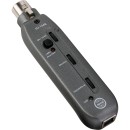
Senal XU-1648 |
VS | ||
|---|---|---|---|
| 1 Input at 48 kHz | Channels of I/O | 1 Input / 2 Output | 1 Input / 1 Output |
| 48 kHz / 16-Bit | Maximum Sampling Rate | 48 kHz / 16-Bit | 96 kHz / 24-Bit |
| 1 Preamp | Number of Microphone Inputs | 1 | 1 |
| 1x XLR 3-Pin Mic Input 1x 1/8" / 3.5 mm TRS Headphone Output |
Analog Audio I/O |
1x XLR 3-Pin Mic Input 1x 1/8" / 3.5 mm TRS Headphone Output |
1x XLR 3-Pin Balanced Mic Input 1x 1/8" / 3.5 mm TRS Headphone Output |
| USB-B | Host Connection | Mini-USB | 1x USB-A |
| Windows macOS |
OS Compatibility |
macOS Windows XP or Later |
Windows 7 or Later (32-/64-Bit) macOS 10.6 or Later |
| USB Bus Power | Power Requirements | USB Bus Power | USB Bus Power |
